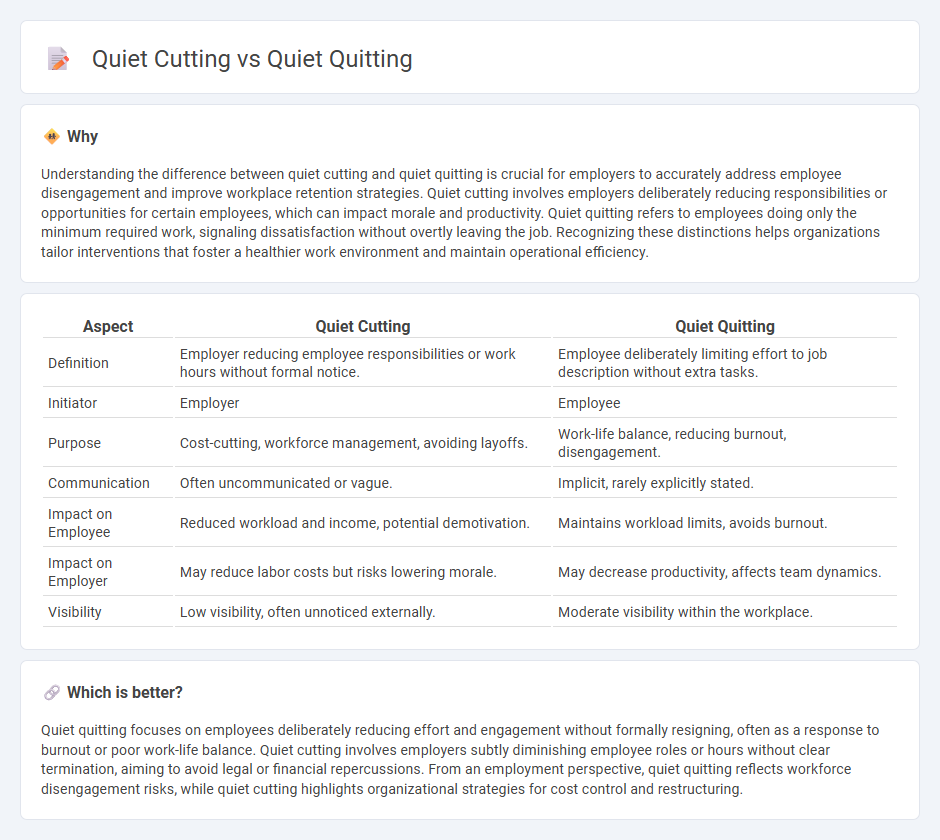
Quiet quitting refers to employees strictly adhering to their job descriptions without taking on extra responsibilities, while quiet cutting involves employers subtly reducing staff involvement or benefits to manage workforce costs. Both trends reflect changing workplace dynamics and employee-employer relationships in the modern labor market. Explore the nuanced impacts of quiet quitting and quiet cutting on employment strategies and workforce management.
Why it is important
Understanding the difference between quiet cutting and quiet quitting is crucial for employers to accurately address employee disengagement and improve workplace retention strategies. Quiet cutting involves employers deliberately reducing responsibilities or opportunities for certain employees, which can impact morale and productivity. Quiet quitting refers to employees doing only the minimum required work, signaling dissatisfaction without overtly leaving the job. Recognizing these distinctions helps organizations tailor interventions that foster a healthier work environment and maintain operational efficiency.
Comparison Table
| Aspect | Quiet Cutting | Quiet Quitting |
|---|---|---|
| Definition | Employer reducing employee responsibilities or work hours without formal notice. | Employee deliberately limiting effort to job description without extra tasks. |
| Initiator | Employer | Employee |
| Purpose | Cost-cutting, workforce management, avoiding layoffs. | Work-life balance, reducing burnout, disengagement. |
| Communication | Often uncommunicated or vague. | Implicit, rarely explicitly stated. |
| Impact on Employee | Reduced workload and income, potential demotivation. | Maintains workload limits, avoids burnout. |
| Impact on Employer | May reduce labor costs but risks lowering morale. | May decrease productivity, affects team dynamics. |
| Visibility | Low visibility, often unnoticed externally. | Moderate visibility within the workplace. |
Which is better?
Quiet quitting focuses on employees deliberately reducing effort and engagement without formally resigning, often as a response to burnout or poor work-life balance. Quiet cutting involves employers subtly diminishing employee roles or hours without clear termination, aiming to avoid legal or financial repercussions. From an employment perspective, quiet quitting reflects workforce disengagement risks, while quiet cutting highlights organizational strategies for cost control and restructuring.
Connection
Quiet quitting and quiet cutting both reflect a shift in workplace engagement where employees reduce effort or involvement without formal resignation. Quiet quitting involves workers disengaging by doing the minimum required tasks, while quiet cutting refers to employers reducing employee roles or responsibilities subtly to manage costs without overt layoffs. These trends indicate changing employer-employee dynamics driven by shifts in labor market conditions and organizational priorities.
Key Terms
Disengagement
Quiet quitting involves employees reducing effort and engagement without formally resigning, signaling subtle withdrawal from workplace responsibilities. Quiet cutting refers to employers systematically minimizing roles or benefits, leading to diminished employee involvement and morale. Explore deeper insights to understand the impact of disengagement strategies on organizational dynamics and employee well-being.
Involuntary Reassignment
Quiet quitting refers to employees reducing their effort and engagement without formally resigning, while quiet cutting involves an employer's involuntary reassignment or reduction of job responsibilities often without official notice. Involuntary reassignment, a key aspect of quiet cutting, can significantly impact employee morale and job security, highlighting a subtle form of workforce management. Explore more to understand how these phenomena affect organizational dynamics and employee rights.
Workplace Expectations
Quiet quitting reflects employees doing the bare minimum to meet job requirements without overextending themselves, while quiet cutting involves employers subtly reducing staff responsibilities or hours without formal layoffs. Both phenomena highlight shifting workplace expectations, emphasizing work-life balance for employees and cost-efficiency for employers. Explore in-depth insights into how these trends shape modern organizational culture and productivity.
Source and External Links
Quiet quitting explained: Everything you need to know - TechTarget - Quiet quitting means employees do only the tasks strictly in their job description to avoid extra work and improve work-life balance, often as a response to burnout or dissatisfaction.
What Is Quiet Quitting and Can It Be Prevented? - Paychex - Quiet quitting involves employees disengaging gradually by reducing effort and social interaction, distinct from quiet firing where employers push employees to leave.
Quiet Quitting: A Proper Guide to a Very Real Trend - Personio - Quiet quitting describes employees who fulfill job requirements but refuse to go the extra mile, often avoiding overtime and extra projects, with HR encouraged to foster a culture that values employee contributions to counter it.
 dowidth.com
dowidth.com